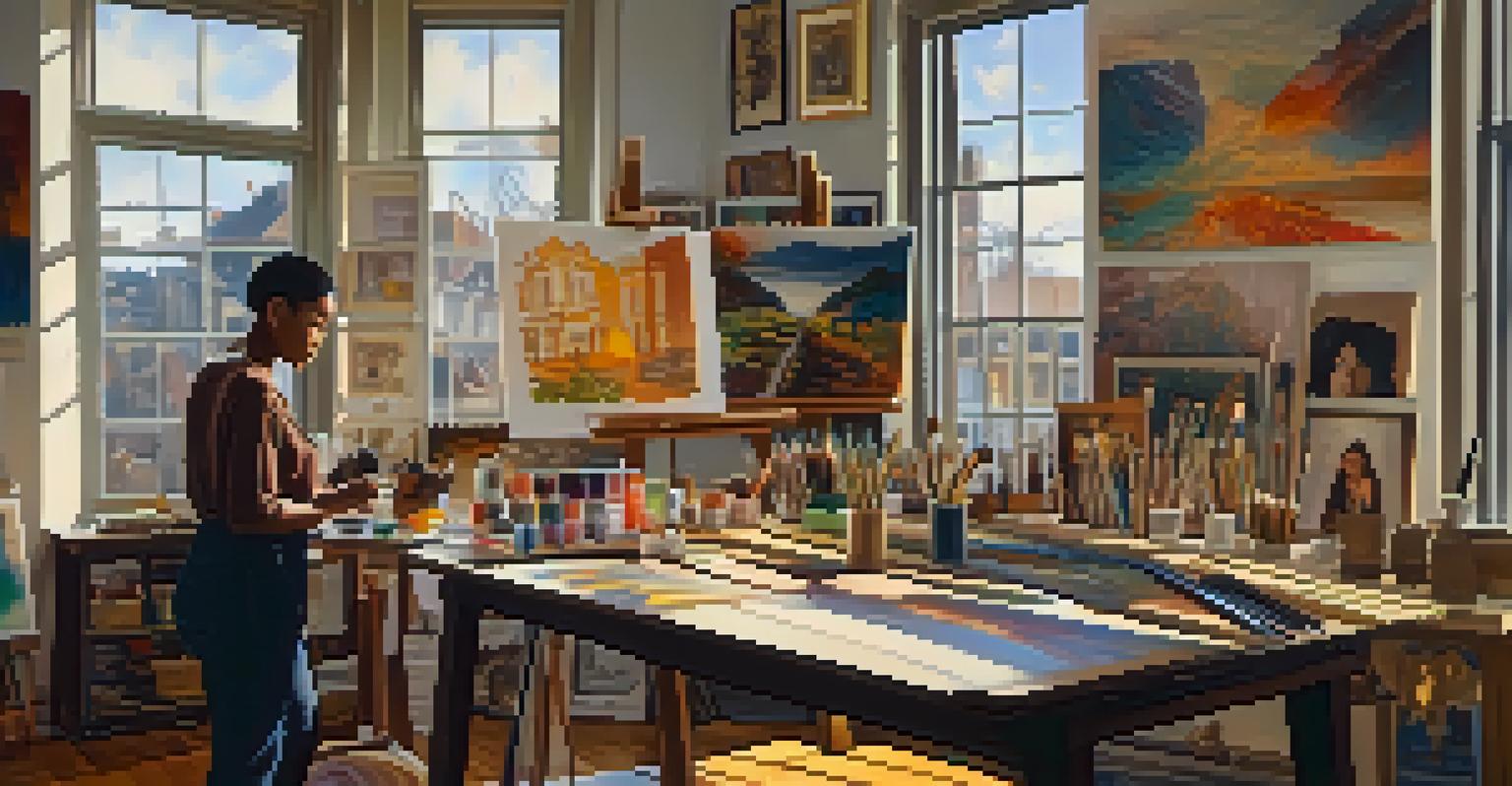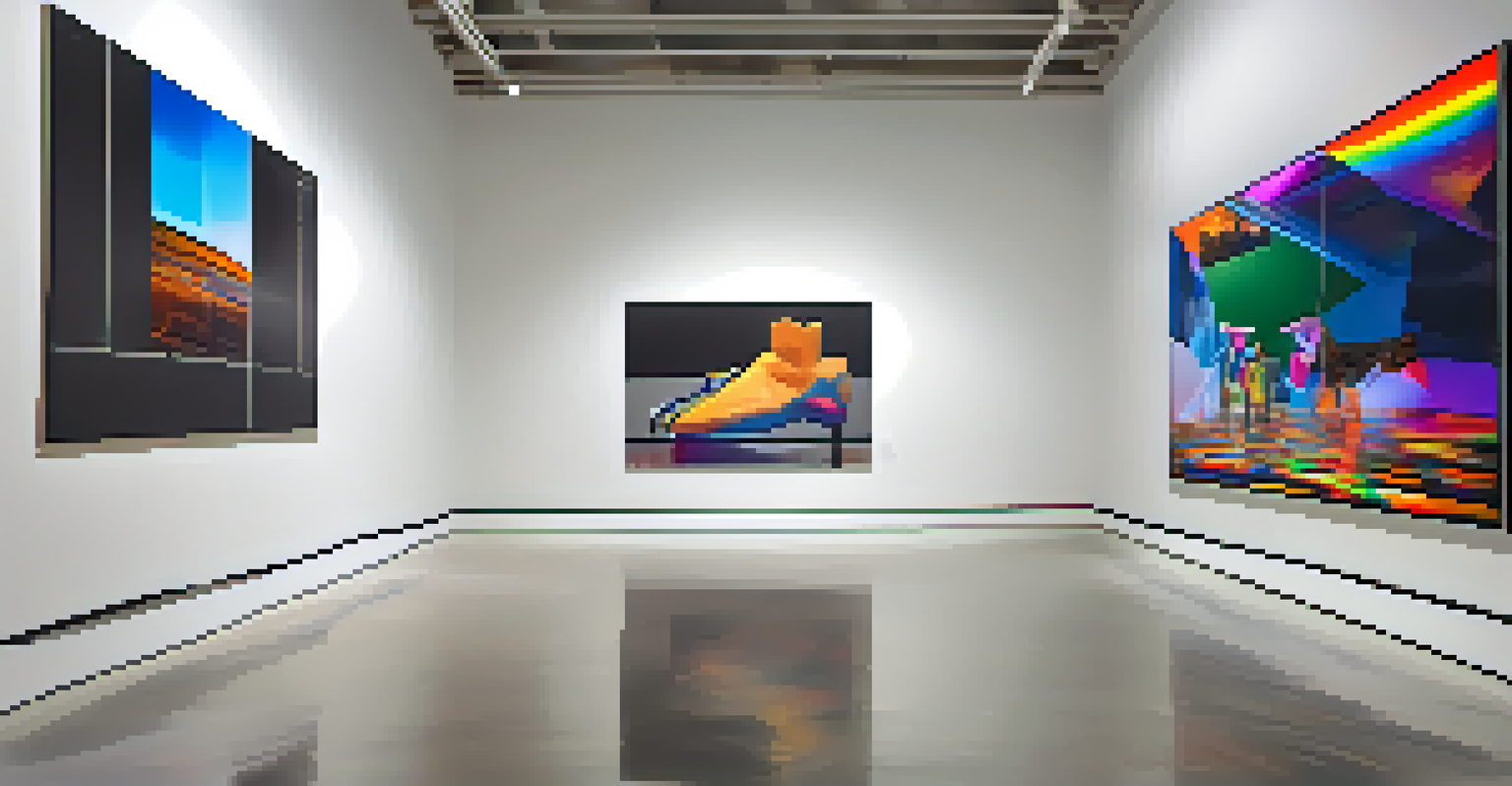Identity in Crisis: Art as a Response to Social Issues

Understanding Identity in Crisis Through Art
Identity in crisis often arises when individuals or communities feel disconnected from their cultural roots or social roles. This disconnect can be triggered by various factors, such as globalization, migration, or societal changes. Art becomes a vital medium for expressing these struggles, as it allows for personal and collective narratives to emerge.
Art enables us to find ourselves and lose ourselves at the same time.
For instance, artists may use visual art, music, or performance to convey feelings of confusion or loss regarding their identities. These expressions can resonate deeply with audiences, creating a sense of shared experience. Ultimately, art serves as a mirror reflecting the complexities of identity in a rapidly changing world.
By examining these artistic responses, we can gain insights into how social issues impact identity formation. This exploration often reveals underlying themes of resilience, community, and the search for belonging, paving the way for meaningful dialogue around these critical topics.
Historical Context: Art and Social Movements
Throughout history, art has played a pivotal role in social movements, acting as a catalyst for change and raising awareness. From the suffrage movement to civil rights, artists have used their talents to challenge societal norms and promote social justice. This historical context underscores the power of art in shaping collective identity and consciousness.

For example, the Harlem Renaissance showcased African American artists who explored themes of race, identity, and culture, significantly impacting societal perceptions. Their works not only celebrated black identity but also addressed the injustices faced by their communities. This movement illustrates how art can confront social issues and inspire action.
Art Reflects Identity in Crisis
Art serves as a vital medium for expressing personal and collective struggles related to identity, allowing individuals to navigate feelings of confusion and loss.
Moreover, contemporary artists continue this legacy by addressing current social crises through their work. By engaging with themes like immigration, gender equality, and racial justice, they contribute to ongoing conversations about identity and challenge the status quo.
Art as a Tool for Personal Reflection and Healing
Art offers individuals a unique avenue for personal reflection, allowing them to explore their identities in a safe and expressive manner. Creating art can be therapeutic, helping people process their experiences and emotions related to identity crises. Through this lens, art becomes not just a medium of expression but a path toward healing.
Art is the most beautiful of all lies.
For instance, individuals grappling with cultural displacement might find solace in creating artworks that reflect their dual identities. This creative process can empower them to embrace their complexities rather than hide them. In this way, art becomes a tool for self-acceptance and growth.
Additionally, sharing these personal narratives through public exhibitions or performances can foster community connections. When individuals see their struggles reflected in the art of others, it builds a sense of solidarity and understanding, further enhancing the healing process.
The Role of Digital Art in Social Identity Discourse
In today's digital age, art has transcended traditional boundaries, allowing for a more diverse range of voices to be heard. Digital platforms enable artists to share their work with global audiences, fostering discussions around identity and social issues. This accessibility is crucial, as it amplifies marginalized voices often overlooked in mainstream narratives.
For example, social media campaigns featuring digital art have sparked conversations about racial injustice and gender equality, reaching millions in a matter of hours. These platforms allow for real-time dialogue and engagement, making art a dynamic tool for social change. The immediacy of digital art can mobilize communities and inspire collective action.
Art Fuels Social Movements
Throughout history, art has been a catalyst for social change, empowering artists to challenge norms and inspire action around issues like racial justice and equality.
Furthermore, digital art often incorporates various multimedia elements, creating immersive experiences that resonate with viewers on multiple levels. This innovative approach can effectively convey complex social issues, making them more relatable and easier to understand.
Artists' Perspectives: Voices from the Frontlines
The voices of artists who confront social issues through their work are essential to understanding the intersection of identity and art. Many artists actively engage with their communities, drawing inspiration from their lived experiences. Their perspectives offer valuable insights into the challenges faced by individuals navigating identity crises.
For instance, an artist might share their story of growing up in a multicultural environment, using their art to explore the tension between different cultural identities. This personal narrative not only highlights individual struggles but also speaks to broader societal themes, creating a collective understanding.
By showcasing these artists and their stories, we can appreciate the diversity of experiences that shape our understanding of identity. Their work often serves as a call to action, encouraging audiences to reflect on their own identities and the social issues affecting them.
The Impact of Art on Society and Identity Formation
Art has the power to influence societal perceptions and shape identity formation in profound ways. When art addresses social issues, it can challenge stereotypes and provoke critical conversations, encouraging audiences to rethink their views. This impact is particularly significant in today's polarized society, where art can serve as a bridge between diverse perspectives.
For example, public art installations that tackle themes of inclusivity can foster community dialogue about acceptance and understanding. These artworks often invite viewers to engage and reflect, creating spaces for discussion and connection. Through these interactions, art can play a transformative role in shaping societal values.
Digital Art Amplifies Voices
In the digital age, artists can reach global audiences, using online platforms to foster discussions about identity and social issues, thereby amplifying marginalized voices.
Moreover, the influence of art extends beyond individual experiences; it can inspire collective movements that advocate for social change. When communities come together around shared artistic expressions, they create a powerful force that can drive progress and redefine identity.
Future Directions: Art as a Continuous Response to Crisis
As we look to the future, the role of art in responding to identity crises and social issues will likely continue to evolve. Emerging artists are increasingly experimenting with new mediums and technologies, pushing the boundaries of how art is created and experienced. This innovation opens up fresh avenues for exploring identity in our ever-changing world.
For instance, virtual reality and augmented reality are becoming popular tools for artists, allowing them to create immersive experiences that challenge traditional narratives. These technologies enable audiences to engage with social issues on a deeper level, fostering empathy and understanding. The integration of art and technology can enhance the dialogue around identity and social justice.

Ultimately, the ongoing dialogue between art and society will remain crucial in addressing identity crises. As artists respond to the complexities of the human experience, they will continue to inspire change and encourage reflection, ensuring that art remains a vital part of our collective journey.